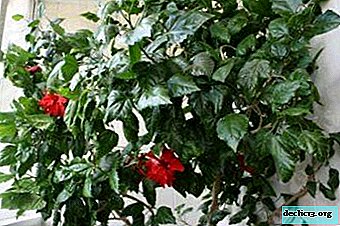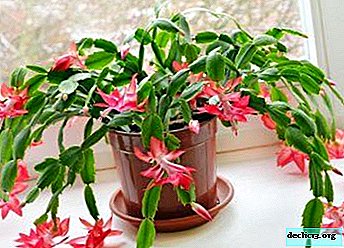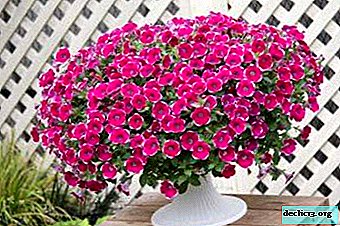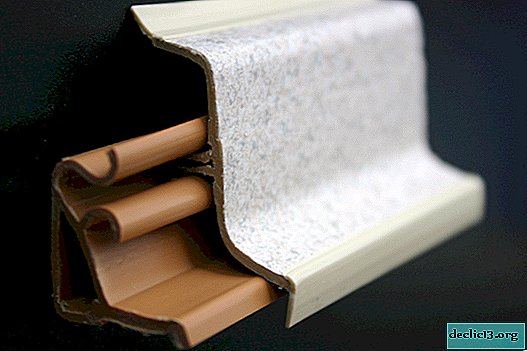Which pot to choose for an orchid - transparent or not? Overview of different types, landing instructions
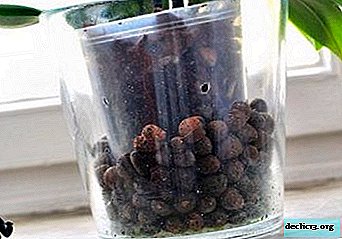
Choosing a pot for an orchid plays a crucial role in ensuring its harmonious growth and development. An improper vessel can cause the root system to rot and dry out. That is why you should pay close attention to the size, material and transparency of the orchid planting pot.
In the article, we will consider whether a transparent pot is required for this plant and what it is for, and whether it is possible to plant an orchid in an opaque, for example, plastic container. We also recommend watching a useful video on this topic.
Is transparency a prerequisite or not?
ATTENTION: When transplanting orchids, the most optimal options are plastic or plastic pots. Is it necessary to plant an orchid in a transparent container? Although the transparency of the pot is not a prerequisite, but most experienced gardeners recommend using them.It is also worth noting that not all transparent materials will do. For example, using glass vessels, you should pay attention to the system of drainage and evaporation of moisture. Many experts do not recommend using glass pots for orchids at all., since such a vessel can lead the plant to disease, decay and death.
Definition
Transparent pots are vessels for plants that transmit light. Thus, by placing the plant in a transparent vessel, you can observe the substrate and the root system without disturbing the flower once again. The material for a transparent pot can be plastic, polyethylene or glass.
Advantages and disadvantages
Pros:
 through the transparent walls of the pot you can always observe the state of the roots and the substrate (more about such a substrate as ceramis can be found here);
through the transparent walls of the pot you can always observe the state of the roots and the substrate (more about such a substrate as ceramis can be found here);- easy to regulate plant watering;
- in case of any problems with the roots, you will easily notice this and will be able to prevent the death of the plant;
- in the event that undesirable animals (snails, slugs, millipedes) start up in the pot, you will quickly find out about this and be able to take action.
But transparent pots definitely have their drawbacks.:
- transparent materials are usually very light, and therefore do not ensure the stability of the pot;
- air tightness.
How does it affect different types of plants?
It is worth noting that transparent materials have almost no physiological effect on the plant, and the ability to monitor the state of the substrate and the root system will allow you to prevent possible problems during its development. But it is also worth noting that excessive vigilance can lead to extremely negative consequences, and especially for inexperienced gardeners.
Before interfering in the growth of a flower, you better consult with specialists. In addition, it is worth paying attention to the specific requirements of different types of orchids. In particular, this concerns the provision of air and light access to the root system. In the case of transparent materials, you will always have to provide openings for oxygen access to the plant, and their number and location should strictly correspond to the characteristics of the type of orchid.
TIP: It is especially recommended to use transparent pots for growing phalaenopsis, since the roots of this type of orchid require a place that is vulnerable to disease and fungus and require constant attention.What and how to choose?
Glass or plastic?
Plastic jar for orchids is a much better choice. This does not mean that glass pots cannot be used, but in order to ensure the development of the plant in a glass vessel, you will need to put a lot more effort.
Translucent or opaque?
Now let's see if it can be planted in an opaque pot. Transparent containers provide several advantages for regulating plant development, but at the same time, opaque materials are environmentally friendly. And although this does not directly affect the flower, this fact may lead some to favor opaque materials.
What will help to find out such a capacity?
 Primarily, a transparent vessel will allow you to monitor the condition of the substrate and root system. Thus, you will be able to notice the symptoms of root disease or the presence of parasites. If you are going to grow orchids in a transparent vessel, you should pay special attention to the color of the roots. In case the roots become gray or brown, you should transplant the plant, and also treat it with an anti-fungal agent.
Primarily, a transparent vessel will allow you to monitor the condition of the substrate and root system. Thus, you will be able to notice the symptoms of root disease or the presence of parasites. If you are going to grow orchids in a transparent vessel, you should pay special attention to the color of the roots. In case the roots become gray or brown, you should transplant the plant, and also treat it with an anti-fungal agent.
The yellowish color of the roots indicates their dryness. When transplanted, they should be trimmed. A healthy color of the roots is silver-greenish. In addition, observing the state of the substrate, it is easier to determine the time of watering the plant and, on the whole, to avoid mistakes when leaving.
Does it affect the flower itself?
In the event that you have equipped the transplant pot in accordance with all the rules, you should not be afraid that plastic or glass will negatively affect the plant. Most experts agree that transparent materials have no physiological effect on orchids. In addition, the access of light to the root system helps to accelerate plant growth.
The consequences of landing in different types of containers
Translucent
When transplanting orchids in a transparent pot, you should pay special attention to its size. If the vessel is too large, the substrate will dry out too slowly, and if it is too small, the plant will often fall, which can injure it (this circumstance is a consequence of the low weight of transparent materials).
It is also worth paying attention to the fact that a transparent vessel largely determines the access of air and light to the roots of the plant. Your choice of pot and its arrangement for subsequent transplantation should take into account the specific requirements of your chosen type of orchid for these parameters.
The one through which the plant is not visible
Primarily, replanting a flower in an opaque vessel, you risk not notice the symptoms of diseases of the root system. In order to keep the plant in an opaque pot, you will need a lot of floriculture experience, as well as the right feeling of watering. In most cases, this choice will only complicate the care of the plant and increase the likelihood of errors entailing extremely negative consequences, up to the death of the plant.
Step-by-step landing instructions
Glass
Recommendation for transplanting orchids in a glass pot:
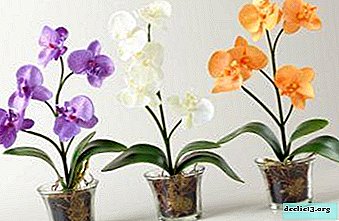 Choose a healthy orchid for transplanting into a pot without draining.
Choose a healthy orchid for transplanting into a pot without draining.- Choose a good soil for the plant. The main requirements for such a soil will be the presence in it of whole pieces of bark (size from 1-3 centimeters) and its breathability.
- Choose the right vessel for the flower. The main criterion for his choice should be size. It should not be too large (this will entail drying of the substrate), but not too small. It is recommended to choose a pot that will be a bit cramped for the plant. Orchid roots should be located along the walls and fill a larger space of the pot, reaching the bottom of the pot.
- Choose the right time for an orchid transplant. As a rule, this is the period after its flowering.
- Use sphagnum moss as the correct layer of soil.
Step-by-step instruction:
- Remove the orchid from the old pot.
- Put the plant in a bowl of warm water and leave to soak.
- Rinse off the rest of the earth with a shower.
- Inspect the roots for rotting or damage. You can identify the problem by the color of the roots.
- Prepare the ground for transplanting. Pay particular attention to drainage, as it will help minimize the effect of glass material on moisture evaporation.
- Lay a layer of ceramic shards up to 5 cm high.
- Fill the ground with a new pot.
- Place the dried orchid in the ground.
Watch the video about planting orchids and a glass pot:
Plastic
Planting an orchid in a plastic pot is also not difficult:
- Prepare everything you need (soil, glass pot, sharp knife, scissors or secateurs, cinnamon, charcoal or activated carbon, fungicide, if there has been rotting, there were dark spots on the stem).
- Water the plant before taking it out of the pot.
- Remove the plant from the old soil. If the roots sprouted through the drainage holes of the plastic pot, then carefully cut it with manicure scissors so as not to tear and break the roots growing from the drainage holes.
- Wash the glass jar for the plant with a chlorine-based product.
- Cut dry and rotten roots. You can identify them by color.
- Carefully remove all dry parts near the root neck of the orchid, where the plant is in contact with the ground.
- Treat all places of root cuts and possible cuts of the base of the orchid with crushed activated carbon or cinnamon.
- Leave the plant to dry for several hours.
- Place the orchid in the middle of the pot so that the roots are located around the walls of the pot.
- Make drainage holes.
- Hold the plant by the root neck and fill the pot with soil so that pieces of bark fill the entire space between the roots.
- Tap the vessel on the walls so that the soil is donkey.
- Do not water the transplanted orchid for 5-7 days. Spraying is allowed.
Watch a video about planting an orchid in a transparent plastic pot:
Planting in a pot of another dense material
Instruction:
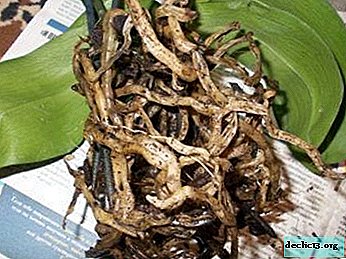 Inspect the roots for rotting or damage. You can identify the problem by the color of the roots.
Inspect the roots for rotting or damage. You can identify the problem by the color of the roots.- Cut dry and rotten roots.
- Treat all places of root cuts and possible cuts of the base of the orchid with crushed activated carbon or cinnamon.
- Prepare the ground.
- Fill the ground with a new pot.
- Place the orchid in the middle of the pot so that the roots are located around the walls of the pot.
- Tap the vessel on the walls so that the soil is donkey.
Conclusion
So, we figured out why the orchid is planted mainly in transparent pots. And still remember that no matter which pot you choose - transparent or opaque, glass or clay - the main thing that remains is the ability to take care of the plant. And the main role here is played not by the material, but by the ability to select the parameters for the vessel in accordance with the requirements of your orchid.

 through the transparent walls of the pot you can always observe the state of the roots and the substrate (more about such a substrate as ceramis can be found here);
through the transparent walls of the pot you can always observe the state of the roots and the substrate (more about such a substrate as ceramis can be found here); Choose a healthy orchid for transplanting into a pot without draining.
Choose a healthy orchid for transplanting into a pot without draining. Inspect the roots for rotting or damage. You can identify the problem by the color of the roots.
Inspect the roots for rotting or damage. You can identify the problem by the color of the roots.






